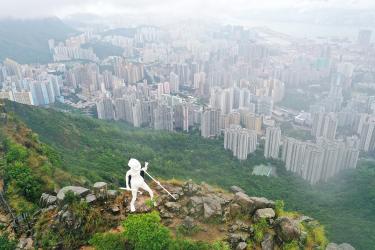Pro-democracy protesters early yesterday hauled a 4m statue known as “Lady Liberty” to the top of a famous Hong Kong mountain, announcing the peak would be its “final resting place.”
The statue depicts a female protester in a gas mask, protective goggles and helmet, an umbrella in one hand and a black flag in the other, proclaiming the protest slogan “Liberate Hong Kong, revolution of our times.”
It was a regular feature at larger, more peaceful rallies this summer, eliciting cheers when it was wheeled in by volunteers and transported around the territory on the back of a truck.
However, organizers yesterday said Lady Liberty had made her final journey as they unveiled her at the top of Lion Rock, a 495m peak overlooking a forest of skyscrapers that is intimately linked to the territory’s democracy movement.
Alex, a 32-year-old protester who created the statue, said volunteers used the cover of night to carry the 80kg artwork up the steep path to the summit.
“We had a team of 16 climbing professionals carrying her in two main pieces all the way to the summit, while another 16 members carried equipment and supplies,” he told reporters, only giving his first name.
“Lion Rock will be the final resting place of the Lady Liberty of Hong Kong,” the team said in a statement, adding that it would be up to authorities to what to do with it.
Named because its shape resembles the big cat, Lion Rock has been a symbol of Hong Kong’s pro-democracy movement for years, with large banners demanding freedoms or criticizing Beijing frequently unfurled by hardy protesters.
“Lion Rock spirit” is used by Hong Kongers to summarize the territory’s can-do attitude — as well as its reputation for liberty compared with authoritarian China.
The mountain overlooks Kowloon’s densely packed working-class districts, where many escaping communist China during the worst excesses of the era of Mao Zedong (毛澤東) settled.
During 2014’s “Umbrella movement” pro-democracy protests, demonstrators unfurled a huge yellow banner down one of the rock’s cliff faces, linking the mountainside to modern-day acts of civil disobedience.
During the Mid-Autumn Festival last month, hundreds of protesters gathered on Lion Rock and other peaks surrounding the territory shining laser pens and lanterns.
Alex said it was inspired by the “Goddess of Democracy” statue that pro-democracy protesters erected in 1989 inside Tiananmen Square before the Chinese government crushed the movement.
A version of the Goddess of Democracy is a feature of the annual June 4 Tiananmen vigils in Hong Kong, the only place in China where commemorations of the crackdown can be held.
However, with the territory rocked by unprecedented protests aimed at halting sliding freedoms under Beijing’s rule, advocates wanted to create a Hong Kong version of the Goddess of Democracy.
Much like the protests themselves — which are leaderless and organized online — the design for Lady Liberty was crowd-sourced.
“We invited design proposals on LIHKG, organized a universal vote asking people to pick their favorite design,” Alex said, referring to the most popular forum for Hong Kong protesters.
Asked why they had chosen Lion Rock to be the statue’s final resting place, he said it was “a symbolic gesture to infuse a refreshed mindset for the fight for democracy.”
The mountain and the statue represented “the fundamental values and beliefs” of the protest movement, he said.
Source: Taipei Times - 2019/10/14





















